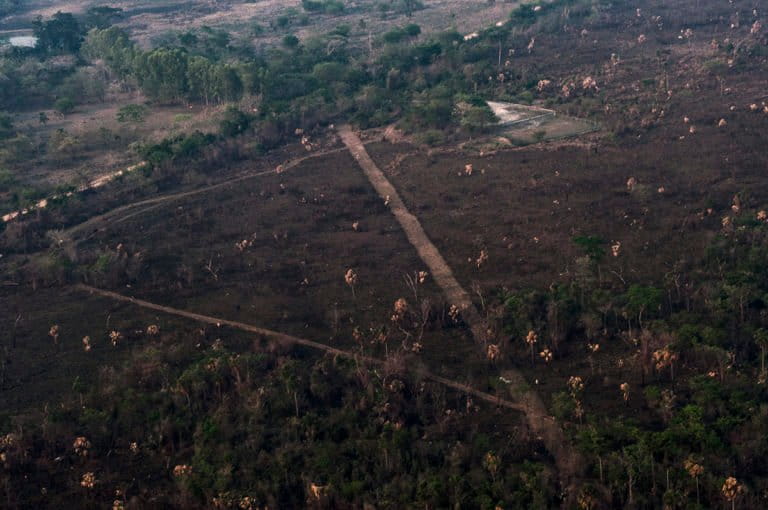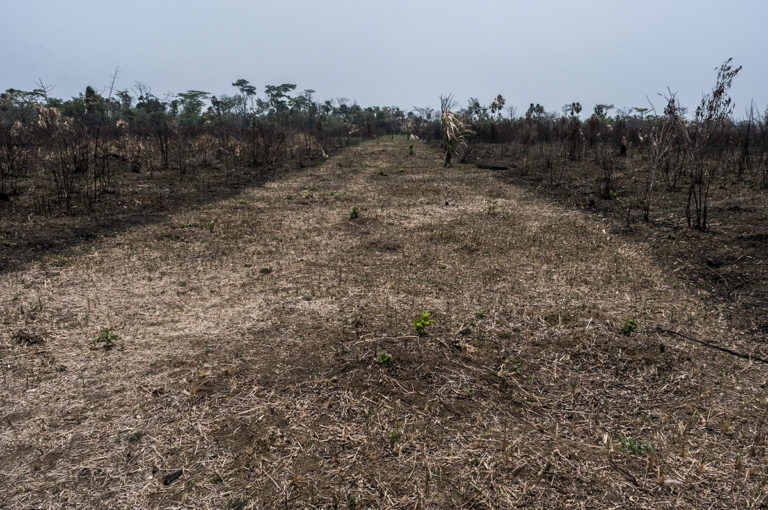- Such clandestine landing strips are often built in forest reserves by people who claim to be cattle ranchers, but are actually working for drug traffickers.
- These illegal structures pose a threat to the Laguna del Tigre National Park.
- What does the head of Guatemala’s anti-drug unit think about this new secret runway that has just been discovered?
(Immediately after this collaborative report by Mongabay Latam and Guatemalan investigative news outlet Plaza Pública was published, government troops were deployed to destroy the runway)
On the 26th of April, two reporters flew over the Laguna del Tigre National Park, located in the San Andrés municipality in the department of Petén, intending to monitor fires that were devastating the protected area.
Whilst up in the air, the plane flew over the Xan oil field, which has been in operation for the Franco-British company Perenco since 2001. It was here that the industrial plant, chimneys and their large tarmac runway could be seen. They then continued to fly north when suddenly they spotted what was clearly a secret runway: a basic 1km strip that crossed a field and a bit of forest, and that started barely 25 meters from one of Perenco’s oil wells, the Xan-30.

The experienced pilot who flew over the area was in no doubt that this was a runway. He pointed out that its orientation was ideal given the prevailing winds.
Afterwards, the captured photos were shown to Aldo Chapas, the head of the Guatemalan anti-drug unit. The public prosecutor confirmed that “the strip matches up to a secret runway but in order to confirm it, there would need to be an investigation and the General Civil Aviation Authority would need to be consulted to see if the landing strip had authorisation.”
When the head of Civil Aviation, Carlos Velázquez Monge, was asked which runways within the Laguna del Tigre National Park have authorisation, it turned out that Perenco’s tarmac runway is the only one. This supposed secret runway is a bit paradoxical: half way up the strip it goes into a small forest area. It’s clear that there are trees on the edge of the strip. In talking with that pilot and the public prosecutor, there are two possible explanations: either the strip isn’t yet finished and the owners haven’t got round to removing all the vegetation, or this small clump of woodland serves to hide the light aircraft that land there. What’s more, the cows that graze amongst the trees demonstrate that the plot of land has been occupied by someone who has invaded a protected area.


Two days after the flight, the journalists travelled to the Xan area and visited the Xan-30 well. Walking around, it was clear that there were only a few steps between the apparent secret runway and the fence surrounding the oil well. The strip is about four meters wide and the vegetation on either side has been burned, although some small pieces are beginning to sprout again. This could indicate that the fire, which struck the park two weeks before the visit, cleared a part of the landing area that was hidden among vegetation.

The Xan-30 well is situated 5km from the Perenco’s focal area and 6km from a military detachment for jungle operations. The apparent secret runway is easy to get to, both the runway and the well are adjacent to the main road that runs through the Laguna del Tigre National Park. The dirt track road – which is very well maintained – connects those living in El Naranjo to the Xan field, and then continues towards Los Cerritos and La Paz, which are on the border with Mexico. Once in the oil-production area, signs lead the way to well 30.
During the visit, journalists chatted with one of Perenco’s technicians who, alongside a security officer from the company Visersa, carried out routine checks on the other Xan wells. The technician explained that all 46 Xan wells were checked every day.

Perenco documents show that Xan-30 is an active injection well, in which the oil tanker reintroduces the acid water produced by oil extraction into the subsoil.
Perenco executives were asked if they knew about the existence of runway. The director of corporate cross-border affairs, Antonio Minondo Ayau, responded in an email: “We had no knowledge of the existence of the runway you’re talking about.”
It was also asked if the company knows any of the people who had occupied the land surrounding the well. “No, we do not know the identities of those who live on the land surrounding the Xan-30 well,” was the response from Minondo Ayau. He added: “Perenco Guatemala on several occasions has denounced the existence of invasions and fires to the National Council for Protected Areas (CONAP).”

The Army’s press executive, colonel William García, stated that he was not up-to-date regarding the construction of a secret runway next to the Xan-30 well. He said that one of the tasks of the Army is to patrol the Laguna del Tigre in order to detect and destroy all such types of illegal infrastructures. He indicated that there are currently 65 runways in the park, 23 of which have been blown up.
Perenco in the department of Petén
According to the public prosecutor, Aldo Chapas, “the proximity of the Laguna del Tigre reserve to Mexico makes it a key place for drug traffickers, since their light aircrafts from South America can touch down there, and the drugs can then be brought into Mexico.”
During the flight over the park, another two secret runways were actually spotted. However, these were in remote areas such as Triángulo Candelaria, north of the Laguna del Tigre National Park, and not in any industrial areas that are strategically important for Guatemala, like the area in which Perenco operates, nor are they as close to a military detachment.

The public prosecutor, Aldo Chapas, stated: “When a secret runway is discovered, it’s assumed that it’s used for drug trafficking.” He also added that it can also be used for other illegal activities such as human trafficking, people smuggling and the smuggling of firearms or contraband.
A report published in 2011 by the US organisation Insight Crime titled Grupos de Poder en Petén: Territorio, política y negocios (Power Groups in Petén: Territory, Politics and Deals) presented the role of Perenco in the network of forces and alliances that are in Petén, and in the Laguna del Tigre National Park in particular. According to the researchers, the transnational company, alongside Manuel Baldizón, Manuel Barquín, Julián Tesucún, Javier López (all local leaders from the Conservative Patriotic and Unionist Parties) and the Mendoza family, who are linked to organised crime in Guatemala (drug trafficking, land grabbing and murders), are the sometimes-rival, sometimes-allied forces that occupy the area.

“In this amalgam of interests, the company Perenco plays a central role and may continue to do so depending on its executive and legislative support, the backing (real or otherwise) of the communities that live in the area and cohabitation with criminal groups who have already taken over substantial pieces of land within the protected area,” stated the report from 2011.
In the presence of the military detachment that guards the entrance to the Xan oil field, there is a gate and a control station run by the National Council for Protected Areas (CONAP) and the Army. When the group of journalists were passing through these controls, the authorities had just stopped a pick-up truck carrying a group of people from the countryside. They were ordered to get out of the truck and line up. Under the watchful eye of the soldiers and CONAP park rangers, they had to open their rucksacks, empty them and lay out all of their belongings on the white dust of the road. From their forbearing expression and from the testimonies of several of the locals, it’s clear that these kinds of checks are part of their daily routine.

15 minutes away from this check point, as if it were no big deal, there is a secret runway right next to an oil well.














